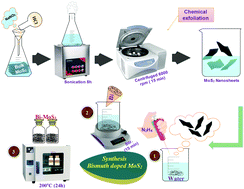Synergistic effect of Bi-doped exfoliated MoS2 nanosheets on their bactericidal and dye degradation potential
Abstract
Nanosheets incorporated with biological reducing agents are widely used to minimize the toxic effects of chemicals. Biologically amalgamated metal oxide nanomaterials have crucial importance in nanotechnology. In this study, bare and bismuth (Bi)-doped molybdenum disulfide (MoS2) nanosheets were synthesized via a hydrothermal method. Different Bi weight ratios of 2.5, 5, 7.5 and 10% were incorporated in a fixed amount of MoS2 to evaluate its catalytic and antimicrobial activities. Doped nanosheets were characterized using XRD, FTIR and UV-vis spectroscopy, FESEM, HRTEM, Raman, PL, DSC/TGA, EDX, XRF and XPS analysis. The XRD spectra confirmed that the doped nanosheets exhibit a hexagonal structure and their crystallite size increases gradually upon doping. The morphology and interlayer d-spacing of doped MoS2 were determined by FESEM and HRTEM. The presence of functional groups in the doped nanosheets was confirmed using FTIR, PL and Raman analysis. The absorption intensity increased and the corresponding measured band gap energy decreased with doping. The thermal stability and weight loss behaviour of the prepared samples were studied using DSC/TGA. The doped MoS2 nanosheets showed a higher catalytic potential compared to undoped MoS2. The doped Bi nanosheets exhibited higher antimicrobial activity against Gram-positive Staphylococcus aureus (S. aureus) and Gram-negative Escherichia coli (E. coli) at different concentrations of Bi (0.075 and 0.1), showing a tendency to counter the emerging drug resistance against pathogenic bacterial diseases. Consequently, significant inhibition zones were recorded against (MDR) S. aureus ranging from 2.25 to 3.3 mm and 3.25 to 5.05 mm at low and high concentrations of doped-Bi nanosheets and against Gram-negative E. coli ranging from 1 to 1.45 mm at high concentrations. In conclusion, the Bi-doped MoS2 nanocomposite has exhibited significant potential for use in industrial dye degradation applications. Its antibacterial properties can also mitigate health risks associated with the presence of several well-known pathogens in the environment.



 Please wait while we load your content...
Please wait while we load your content...